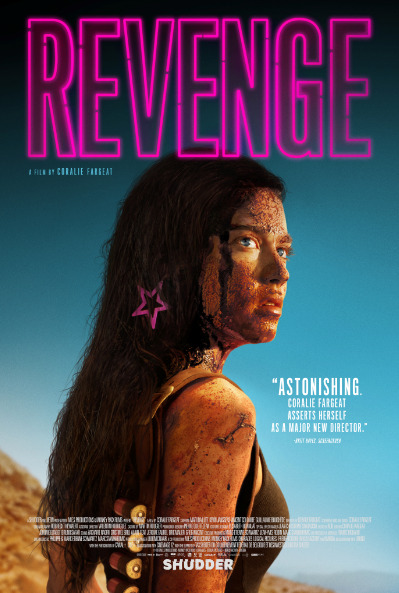The rape-revenge film is reborn in fire and blood in the outrageous, visceral Revenge

Looking back at rape-revenge films produced during the genre’s heyday in the 1970s—not coincidentally, also the decade that gave rise to the women’s liberation movement—there’s one simple question that provides endless insight into a title’s intent and impact: Does it focus more on the rape, or on the revenge? The structure of this particular subspecies of exploitation is so elemental, requiring little more than “woman gets raped, then kills her attacker(s),” that the films serve as empty vessels for their creators’ attitudes about women, violence, and power. Revenge director Coralie Fargeat is very conscious about this dynamic in her debut feature, which stays faithful to the grindhouse spirit while subverting it with an unapologetically aggressive female gaze.
Matilda Lutz stars as Jen, a young American woman who at the beginning of the film has just arrived at an Instagram-ready desert retreat, complete with an infinity pool and pop-art portrait of the Virgin Mary, for a dirty weekend with her wealthy French lover, Richard (Kevin Janssens). Their carnal activities are soon interrupted, however, by the arrival of Richard’s associates Stan (Vincent Colombe) and Dimitri (Guillaume Bouchède), who show up early for a planned hunting trip loaded down with bandoliers of bullets and heavy semi-automatic rifles. The next morning, while Richard is out running an errand, Stan assaults Jen as Dimitri stuffs his face with candies in the next room. Upon his return, Jen is devastated to learn that Richard’s main concern isn’t for her safety, but in keeping her quiet, leading to the shocking act of betrayal that sets the film’s outrageously violent second half into motion.
Fargeat, who also wrote the screenplay, remains deliberately vague about expository details, giving viewers little more than names and nationalities for each character and the general location marker of “remote desert.” Instead, she focuses on visceral detail, continually pummeling the viewer with flashy montage, intensely saturated color, dynamic camerawork, viscid sound effects, and graphic gore effects. Putting aside the heavy-handed imagery of ants and rotten apples, her intention with the film is most obvious in the ways she shoots the human body: Before the assault (which, significantly, occurs almost entirely off screen), the camera lustily follows Jen in skimpy dresses and bikini bottoms, eyeing her like a piece of meat. After her eventual rebirth as a seemingly immortal demigoddess of revenge, the camera once again pans slowly up her body, but this time in a dizzying whirl passing over her scarred torso and dirty limbs. By the end of the film, it’s Richard who’s the object of the camera’s unblinking eye, completely naked and soaked in blood as he desperately scrambles to escape his fate.
That deadpan reversal of predator and prey is typical of the jet-black humor that’s sprinkled throughout the film, exposing Richard and his cronies as both monsters and buffoons. These moments of levity are certainly necessary, for as Jen’s fight for survival grows increasingly intense (think self-surgery with a hot beer can and a hunting knife while high on peyote) and surreal (did we mention the peyote?), the violence crescendos to a level worthy of Fargeat’s forebears in the New French Extremity movement, which all but the most hardened viewers may find difficult to take. (Nitpickers may also have trouble with the inconsistencies in Jen’s killing spree, which pile up along with the body count.) Along with a propulsive, ’80s-inspired synth soundtrack from the mononymous Rob, this extreme violence gives Revenge the texture of a horror movie as well as an action film, uniting the nightmarish nature of our heroine’s ordeal and her ultimate, battle-scarred rise from its ashes. Fans and filmmakers wondering if it’s possible to update exploitation films for the post-#MeToo era without sacrificing their transgressive appeal: Your answer has arrived, and it’s a feverish, blood-soaked “yes.”